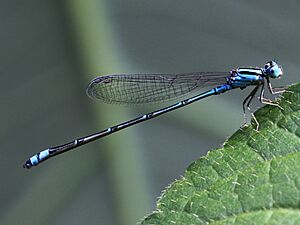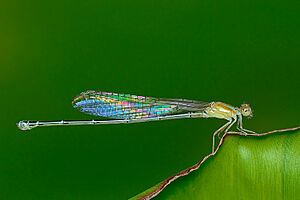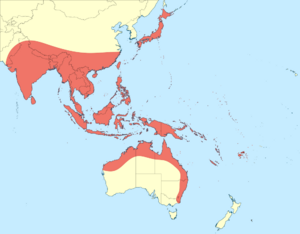Blue riverdamsel facts for kids
Quick facts for kids Blue riverdamsel |
|
|---|---|
 |
|
| Male | |
 |
|
| Female | |
| Conservation status | |
| Scientific classification | |
 |
The blue riverdamsel is a common and beautiful insect. It's a type of damselfly and is also known as the blue sprite or blue grass dart. Damselflies are often mistaken for dragonflies, but they are usually smaller and hold their wings differently when resting.
Contents
Where Do Blue Riverdamsels Live?
This damselfly species can be found in many places around the world! In Australia, you can spot them in New South Wales, Northern Territory, Queensland, Victoria, and Western Australia. They also live in parts of Africa, like southern Nigeria, and across many countries in Asia, including India, China, Japan, Thailand, and Philippines.
What Do Blue Riverdamsels Look Like?
The blue riverdamsel is a medium-sized damselfly, growing up to about 38 millimeters long. That's about the length of a paperclip!
Male Blue Riverdamsel
Male damselflies have pale blue eyes that are dark on top. Their main body part, called the thorax, is a bright blue with broad black stripes on its back and thinner black stripes on its sides. The first two parts of their abdomen (body) are blue with black marks. The mark on the second part often looks like a chalice (a fancy cup) or a thistle-head (a spiky flower). Parts 3 to 7 of their abdomen are black on top and blue on the sides. Parts 8 and 9 are blue, with thin black rings at the very end. The last part, segment 10, is black on top and blue on the sides.
Female Blue Riverdamsel
Female blue riverdamsels have bluish-green eyes, sometimes with a hint of orange. Their bodies are marked similarly to the males, but the black colors are often replaced by orange or paler shades. Their abdomen colors are like the males, but usually lighter. Segments 8 and 9 are black with thin blue rings, and segment 10 is pale blue.
Blue riverdamsels can look a bit like other damselflies, such as the common bluetail and the eastern billabongfly. Female blue riverdamsels are often blue-grey to grey-green in color.
Where Do Blue Riverdamsels Live?
You can easily find these damselflies near water, whether it's flowing like a river or still like a pond. They love to rest on plants that grow in the middle of ponds or along the water's edge. They lay their eggs and grow up in ponds, lakes, and streams. This species prefers flat areas, like plains. In hilly regions, you might find similar damselflies like Pseudagrion malabaricum or Pseudagrion australasiae instead.







